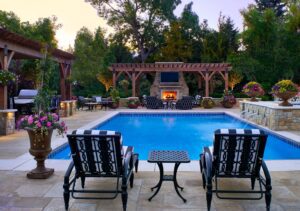Installing an inground pool is a significant investment that can elevate your property’s value and transform your outdoor space into a luxurious retreat. However, understanding the costs involved is crucial for planning effectively. The final price of an inground pool depends on several factors, including the type of pool, materials used, size, location, and additional features.
In this comprehensive guide, we’ll explore the average costs of inground pools, discuss the key factors influencing pricing, and provide insights into ongoing maintenance expenses. Whether you’re envisioning a simple vinyl liner pool or a custom-designed concrete masterpiece, this article will help you make informed decisions for your project.
Average Costs of Inground Pools
Understanding Typical Price Ranges
The cost of an inground pool can vary widely depending on its type and complexity. On average, homeowners spend between $44,000 and $87,000 for a standard-sized pool. However, luxury designs with custom features can exceed $100,000, especially when high-end materials like concrete or elaborate landscaping are included.
It is important to note that regional variations also play a role in pricing. Labor costs and material availability differ across states, which can influence the total expense. For instance, pools in warmer climates like Florida may be slightly less expensive due to higher demand and more experienced contractors in the area.
Comparing Pool Types and Their Costs
The type of pool you choose significantly impacts the overall cost. Vinyl liner pools are generally the most affordable option, with prices starting around $25,000 for basic designs. Fiberglass pools are slightly more expensive but offer durability and low maintenance requirements. Concrete pools are the most customizable but come with a higher price tag due to their labor-intensive installation process.
Key Factors Influencing Pool Costs
Size and Shape of the Pool
The size of your pool is one of the most significant factors affecting its cost. Larger pools require more materials and labor, which increases expenses. Additionally, the shape of the pool can influence pricing; rectangular designs are often less expensive than freeform or custom shapes that require specialized construction techniques.
For example, a standard rectangular pool measuring 12×24 feet might cost less than a kidney-shaped or L-shaped design of similar dimensions due to differences in complexity.
Materials Used
The choice of materials is another critical factor in determining costs. Vinyl liner pools are budget-friendly but require periodic liner replacement every 7–10 years. Fiberglass pools offer excellent durability with minimal upkeep but have limited customization options compared to concrete pools. Concrete (or gunite) pools are highly customizable but come with higher maintenance costs over time.
Each material, including options for Castle Rock patios, has its pros and cons depending on your budget and design preferences.
Additional Features That Impact Costs
Adding features to your swimming pool can enhance its functionality and aesthetic appeal but also increase expenses significantly. For instance, installing a heating system can cost between $1,500 and $5,000, while LED lighting might add another $700 to $3,000 to your budget. Water features like waterfalls or fountains typically range from $1,000 to $5,000, depending on their size and complexity.
Decking is another important consideration; concrete decks are more affordable than natural stone or pavers but may lack visual appeal for some homeowners. Landscaping around the pool area can also add thousands of dollars to the final cost depending on the scope of work involved.
Maintenance Costs to Consider
Annual Maintenance Expenses
Owning an inground pool comes with ongoing maintenance costs that should be factored into your budget. These include cleaning supplies, chemicals for balancing water pH levels, electricity for running pumps and heaters, and occasional repairs or replacements for equipment like filters or pumps. On average:
- Annual maintenance costs range from $960 to $1,800, depending on the type of pool;
- Saltwater systems tend to have lower chemical expenses but may require periodic replacement of salt cells.
Regular maintenance ensures that your pool remains safe and enjoyable for years to come while preventing costly repairs down the line.
Repairs and Longevity
Over time, certain components may need repair or replacement due to wear and tear. For example:
- Pool pumps typically last 8–12 years before needing replacement;
- Vinyl liners require replacement every 7–10 years at an average cost of $4,000–$6,000;
- Concrete surfaces may need resurfacing after 10–15 years at a cost ranging from $10,000 to $20,000.
Understanding these long-term expenses helps you plan for the full lifecycle cost of owning an inground pool.
Tips for Budgeting Your Pool Project
Prioritize Essential Features First
When planning your budget, focus on essential elements such as size and material before adding optional features like waterfalls or automation systems. This approach ensures that you allocate resources effectively without overspending on non-essential upgrades.
Get Multiple Quotes from Contractors
Obtaining estimates from several reputable contractors allows you to compare pricing and services offered. Look for professionals with strong reviews who provide detailed breakdowns of costs so you can make informed decisions about where to allocate your budget.
Frequently Asked Questions (FAQ)
1. How much does it cost to install an inground pool?
The average cost ranges from $44,000 to $87,000, but luxury designs can exceed $120,000 depending on materials used and additional features included.
2. What is the cheapest type of inground pool?
Vinyl liner pools are typically the most affordable option with prices starting at approximately $25,000 for basic designs.
3. How long does it take to install an inground pool?
Installation timelines vary by type but generally take 6–12 weeks for concrete pools and 2–4 weeks for fiberglass or vinyl liner options.
4. Are there financing options available for pool installation?
Yes! Many contractors offer financing plans or work with third-party lenders to help homeowners manage upfront costs more easily.
5. Do inground pools increase home value?
Yes! An inground pool can increase property value by approximately 5%–7%, particularly in warmer climates where outdoor living spaces are highly desirable.
6. What are the long-term maintenance costs associated with owning a pool?
Annual upkeep typically ranges from $960 to $1,800, depending on factors such as size and type of filtration system used (e.g., saltwater vs chlorine).
By carefully considering these factors—you’ll be well-prepared not only financially but also logistically when embarking on creating your dream backyard retreat!




